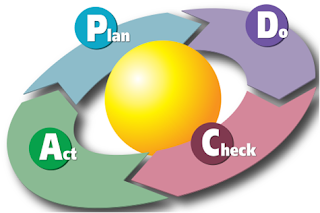At the base of PRINCE are the six aspects and project levels. The project levels are very important. Because PRINCE defines different management levels to blame when stuff goes haywire. The aspects give boundaries to the work and can be used as key performance indicators. These aspects are: scope, time, risk, quality, benefits and cost. Aspects are valid for any piece of work that is going to be done, whether using PRINCE or not.
While PRINCE is very flexible in it's implementation there are seven principles that should never be broken. First of all is the business case. This document is sacred, it defines the boundaries of our project and justifies why the project is run. It is a living document and grows with the project till the end. Putting the whole project on paper is a contribution to the success of the project. The next important factor in PRINCE is that there should be a learning experience. So each project maintains a log of lessons learned. This log is delivered and stuffed in a closet, so after the project is finished behind schedule, the log will be incomplete, obsolete and using space. No one will ever look at this log again. Because there is a need to blame people when the project fails, and it will fail, roles and responsibilities are to be defined. Individuals are able to play multiple roles if it suits them, and they should be hierarchical, so propagate problems through a decision tree. At the centre is the project organization, with all contributors to the success of the project as stakeholders. One of the control instruments that is very strong in PRINCE, is stage management. Each stage that will make up the project, is planned and controlled with updating documentation, so there will be no chance to go over time or budget. And because there is a lessons learned log from the last couple of months, there can be a detailed planning of the next stage. Oh, wait, that log is never being maintained, oh well, the planning will then being done as has always been done, by project management. PRINCE depends very strong on a hierarchical structure of the organisation, management by exception is done by escalating problems, until a suit will make a discision on how to solve the issue. PRINCE is not a normal project management solution, instead of focusing on non-deliverables it focuses on products. The products delivered from a PRINCE project are the quality requirements. This excellent product will go right up for sale to the highest bidder. Customers always get thrilled when they can acquire new quality requirements. I might sound a little sceptical on this, but there is nothing more satisfying than brushing your teeth with new quality requirements of a toothbrush. The last principle that makes PRINCE such a strong method, is that it is suited for project environments; it lets you manage size, complexity, importance, time and risk.
With enough management tooling on board, PRINCE is perfect for a hierarchical project organisation where documentation and blaming is at the spill and threads are determined by non-experts. Management is identified as the most important factor in this method and the management products are key to a successfull failure. A lot of time and effort is spend on creating and maintaining these artifacts like approaches, reports and logs. Because a lot of people are working on these management products there is extensive knowledge about the product and problems can be mitigated in advance. By granting control to the least knowledgeable people, and make contributors to the product work on management products, an effective way of working to the end of a product will be omitted. As a result, most projects are a success, but there will be no working product at the end, and a lot of documentation to prove it.
With the new movements like agile software development, scrum, kanban et cetera there is lack of control. Therefore PRINCE2Agile has been developed. While an agile framework is a project environment, it needs to be managed by PRINCE. PRINCE will measure the project outcome, while scrum is used to develop products for customers. With PRINCE decisions will be made by management so the project will be successfull. Risk will be mitigated by placing PRINCE on top of an agile software development framework and makes management responsible instead of software developers.
All in all PRINCE is since it's inception, in either '89 or '96 (depends on who you ask), a leading tool for management. With this tool, management is able to predict when a project should have ended, why the customer get's an outdated product and why it is way over budget and time. While some people might think a customer or the product for that customer might be important, we all know better. Management did what the customer initially asked, the way they found best and have the documents to prove it.


